Laura Ingalls was born on February 7, 1867 outside of Pepin, Wisconsin. We started our Little Journey there and have visited other places Laura lived, but we’d not yet set foot in an actual building inhabited by the Ingalls.
Our last day in De Smet, South Dakota, we made our way to the Laura Ingalls Wilder Historic Homes to change that.
The Laura Ingalls Wilder Historic Homes are operated by the Laura Ingalls Wilder Memorial Society and include the Surveyors’ House from By the Shores of Silver Lake, the First School of De Smet — the very school that Laura and Carrie attended, and the house that Pa built in town in 1887 where the Ingalls lived after Laura married Almanzo and where Pa, Ma and Mary spent their final days.
To view the homes and a replica of the “Brewster School,” The Memorial Society offers visitors a guided tour. The first stop is the Surveyors’ House, which Laura makes sound so large and elegant in By the Shores of Silver Lake. The building is the actual house that once sat on the North shore of the lake and housed the Ingalls family through the winter of 1879-80. Lumber being scarce, it was moved to town in 1884 and was a private residence until the Memorial Society purchased it in 1967 and began restoration.
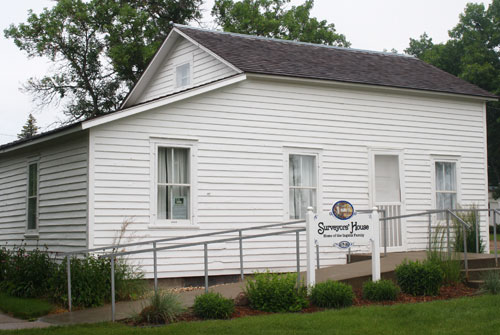
As we walked in, I (quietly) made the same squeal of excitement Laura did when she first explored the house. Of course, Laura’s squeal stemmed from her delight at the stores of goods that filled the house. Mine was enchantment at how the room we entered matched so much of the detailed description in the book — a crate made up for Grace’s trundle bed, a whatnot in the corner, the stairs leading to the attic room and a red and white checkered cloth on the table.
It is all too easy to disregard the realities of what you are looking at when it seems as though you opened a door that Laura just closed. Once you stop oohing and aahing, you remember that someone very deliberately made it look this way just so you could have that feeling of stepping into Laura’s story. But I’m not going to debate history versus her story. I’d rather enjoy and appreciate the effort made to provide tangible reminders of Laura’s story that help make everyone feel more connected to the time and place Wilder described in her book.
To Janet, the actual house seemed small, given the description of the number of homesteaders who spent the night with the Ingalls on the way to file their claims. How did they fit 15 extra men in for the night? The Surveyors’ House may have been large by Laura’s standards and it would have been quite comfortable for just the Ingalls’ family. It was probably quite cozy with a visit from the Boasts. But it must have been cheek-to-cheek with the number of boarders Ma took in during the spring rush.
It was certainly a tight fit with the 20 or so folks on the tour. Perhaps that’s why they don’t permit photography in the house — no room to raise your arms! But photos are allowed in De Smet’s First School. We’d seen a number of one-room schoolhouses, but this was our first that the Ingalls’ girls attended. The school opened in 1880, but soon the school was not large enough for all De Smet’s students. In 1885, the school was sold and became a private residence. When the Memorial Society purchased it and began restoration, they discovered the original blackboard with chalk writings under layers of wallpaper.
The restoration work on the blackboard was amazing as was standing in front of it imagining Laura, in just that spot, presenting the great history of America to the entire town. But what really got my attention was the huge stove in the middle of the room. It was more than twice the size of all the other heaters we’d seen anywhere. Our guide assured us that its size was correct even though it was a later model.
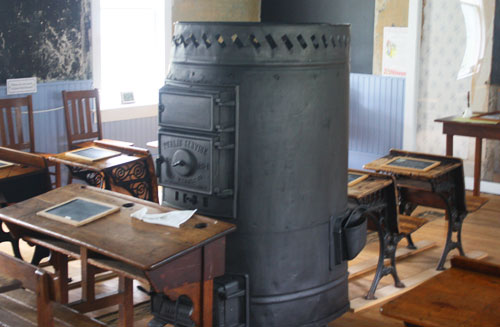
The lack of coal for the school stove during the Long Winter made any school attendance impossible. The Ingalls’ family and other De Smet residents kept themselves warm by burning hay twisted into sticks. When food supplies were nearly depleted, they kept themselves fed that winter by grinding wheat into flour using a coffee grinder. Breece and Avery experimented with the different grinders set up in the classroom and found grinding even a tablespoon of wheat to be exhausting!
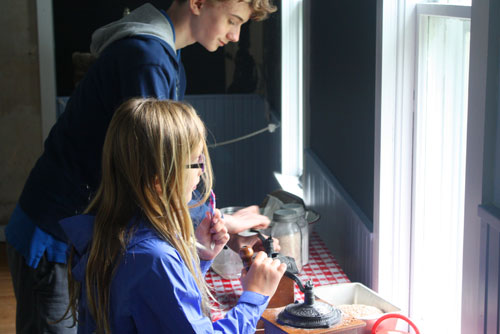
The replica of the “Brewster School” was next on the tour and was definitely more story than history. How can you have a replica of something that never existed? Laura may have taught at the Brewster School in These Happy Golden Years, but Laura Ingalls taught at the Bouchie School. Though the board walls were battened, the little shanty building in De Smet otherwise seems built as described — small and dark with rough furniture and a big stove.
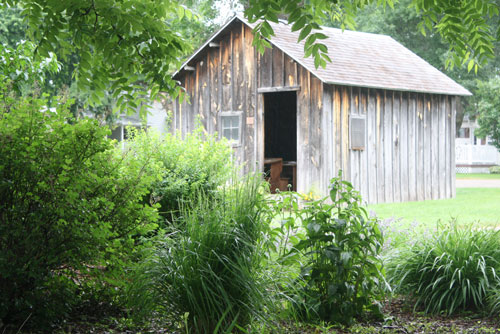
Given her description of the Brewster family, Wilder was probably wise to change the name in her book. But it would have been a good idea to share more here about the real history of Wilder’s first teaching position.
The last historic home of the Memorial Society tour is the home Pa built in town in 1887. It is still in its original location on Third Street and required a quick trip across town. The house is the last house that Pa built and the last house where Pa, Ma and Mary lived. Carrie and Grace also both lived here. Laura, already married when Pa built this house, did spend time with her family there along with Almanzo and daughter Rose.
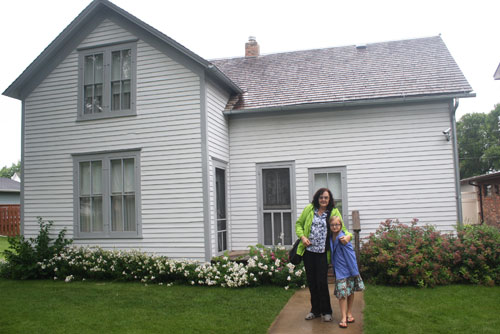
This house was history without Wilder’s literary touch since Wilder didn’t write of it in her “Little House” books. Here you could really feel the spirit of Ingalls family and understand why Wilder wanted to capture them in her books. Ma, Pa and Mary’s interests and industry were on display — from the fiddle and organ that visitors were encouraged to play to Mary’s fine sewing and beadwork to Pa’s clever cabinetry in Ma’s orderly kitchen.
This home is full of excellent reminders that the Ingalls we meet in Wilder’s books were real people and not flawless. The fictional Pa we know is a crackerjack carpenter. And the house Charles Ingalls built on Third Street shows he was genuinely skilled. But not perfect, as evidenced by the uneven and twisted stairway he built to reach the upstairs bedrooms.
No photography allowed in the Ingalls home, but William Anderson’s excellent photographic journey Laura Ingalls Wilder Country: The People and Places Behind Laura Ingalls Wilder’s Life and Books includes several pages on the house on Third Street.
Leaving Third Street behind, we headed back to the Memorial Society to check out their Discovery Center. We all once again donned prairie garb to play school and kitchen, as well as practice Braille. Hunger interrupted, so we headed to Ward’s Store for lunch. After lunch, we all agreed that Ward’s is the best place to eat in De Smet.
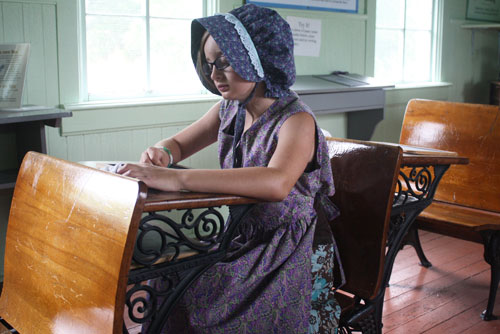
Before we headed out of town for our next Little Journey destination, we wanted to see the spot where Laura and Almanzo had their homestead. It was just north of town and nothing much to see, but did make us wonder if Pa moved to town so soon after Laura left home because he wanted to be closer to his daughter. Or if having lost Laura’s help on the homestead, he needed to be in town for work he could get paid for to support the family.
Our final stop in De Smet was to be Silver Lake. We checked in at the free Depot Museum for directions as we’d gotten differing information about the lake even still being in existence. We were directed to the end of 4th Street and found our Silver Lake.

Like Wilder wrote, “the lake melted into the slough.” There’s a walking trail through the tall grasses and an interpretive display about the wetlands and the lakes. Silver Lake had been drained and used as a dump but now is on its way back to health. We ventured out into the slough, but like Carrie and Mary, objected and turned back when we started to sink into ooze. Like Laura, it is an adventure we wanted, but responsibility (and limited shoes and clothes) called us back to the car and our bigger adventure.

